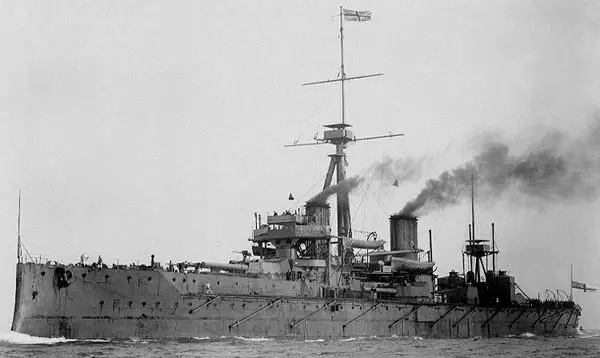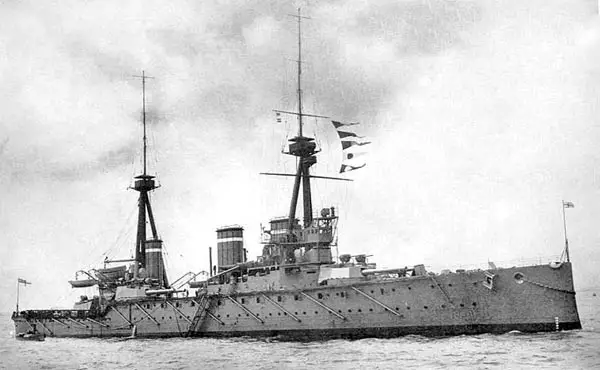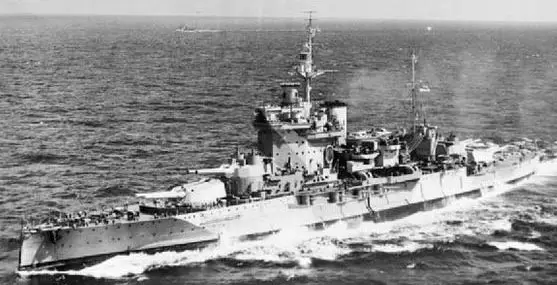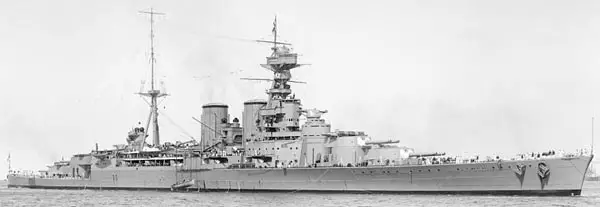|
Significant Capital Ships of the 20th Century By Chuck Hawks It is as unfair to compare capital ships of one generation to those of a later generation, as it would be to compare fighter aircraft of different vintages. Few would dispute the unfairness of comparing the performance and combat effectiveness of an SE-5a, Spitfire, F-86 and F-16, although each was an outstanding fighter plane at the time of its introduction. Similarly, when discussing the most significant capital ships of the 20th Century, they should be evaluated in the context of the time in which they were designed and completed. Certain capital ships caused the navies of the world to sit up and take notice. Often contemporary and future ship designs were recast as a result. It is such groundbreaking ships that are the subject of this article. The specifications provided are taken from Jane's Fighting Ships and Anthony Preston's Battleships of World War One. HMS Dreadnought No 20th Century ship had as much influence on subsequent battleship design as the British Royal Navy's Dreadnought of 1906, inspired by Lord "Jackie" Fisher. Not only was she the first "all big gun" battleship to be commissioned, she was also the first with tripod masts and powered by steam turbines. The shift to steam turbines from reciprocating machinery significantly lowered the ship's center of gravity, allowing a heavier battery to be carried well above the water line. Turbines were more reliable, much smoother in operation and allowed a three knot increase in speed. At a stroke, Dreadnought doubled the main battery broadside of previous battleships, increased protection and achieved a meaningful increase in speed. When commissioned, she could overwhelm any existing capital ship with her gunfire and run it down if it attempted to escape. If faced by a numerically superior enemy battleship force, Dreadnought could escape by using her superior speed. Dreadnought forever changed capital ship design. It is fair to say that she was the single most revolutionary battleship of the 20th Century, as she immediately made all previous battleships obsolete in a way and to an extent that no later capital ship would ever match. Similar subsequent battleships were known, generically, as "dreadnoughts" and earlier battleships as "pre-dreadnoughts." The actual period of her superiority was brief, as both the British Admiralty and foreign navies immediately sought to design Dreadnought style battleships of even greater capability. By the outbreak of the Great War (WWI) in 1914, she was already obsolescent and in July 1918 she was decommissioned. Nevertheless, Dreadnought was the first, and perhaps the most influential, among the significant 20th Century capital ships.  BASIC SPECIFICATIONS
Invincible Class Hard on the heels of Dreadnought came another new, and in many ways similar, class of capital ship from the fertile mind of Lord Fisher. This was the Invincible class, Invincible, Inflexible and Indomitable, the world's first battle cruisers. The original battle cruiser concept was essentially the Dreadnought equivalent of an armored cruiser. The Invincibles were designed to out shoot and out run all existing armored cruisers. They were all big gun (12" main battery), four shaft, steam turbine powered ships similar in size to Dreadnought, but armored to resist cruiser, not battleship, gunfire. The primary differences were a longer and finer hull shape, a substantial reduction in armor protection and a big increase in horsepower, in order to achieve a substantial increase in speed. The thickness of the armored belt was cut almost in half and the horsepower almost doubled. The designed speed was 25 knots and this was exceeded on trials. The Invincibles were much more heavily armed, as well as better armored and faster, than any armored cruiser. They were also much larger and more expensive. Naturally, since the advent of the Invincible class made all armored cruisers obsolete, navies that wished to stay abreast of the latest Royal Navy developments needed battle cruisers of their own. Britain's main naval rival, Germany, commissioned the first response, the battle cruiser Van der Tann, in 1910. When used for the purposes for which they were designed, the Invincible class was very successful. This was demonstrated when Invincible and Inflexible ran down and sank Admiral Graf Spee's raiding force that included the armored cruisers Scharnhorst and Gneisenau off the Falkland Islands in December 1914. However, the Invincibles downfall was that they represented too much of a good thing. It seemed impossible for commanding admirals to resist including them in the battle line, where they were exposed to heavy caliber (not cruiser) shell fire that they were not designed to resist. The result was the explosion and loss of Invincible and two later Royal Navy battle cruisers during the Battle of Jutland. Inflexible and indomitable were paid off at the end of the Great War. Nevertheless, many important navies, including the American, Soviet, German, Japanese, Turkish and French, ultimately designed and/or operated battle cruisers. (See the article "Battle cruisers, Large Cruisers and Pocket Battleships of World War II.")  BASIC SPECIFICATIONS
Orion Class The next significant advance in capital ships was the British Orion class. Completed in 1912, Orion, Thunderer, Monarch and Conqueror were so much larger and more heavily armed than previous dreadnoughts that the press coined the term "super dreadnought" for them and the name stuck. These ships were armed with 13.5" guns, where for generations previous battleships had been armed with guns of no larger than 12" bore. Heavily armored, carrying 10-13.5" guns in twin centerline turrets and displacing about 25,000 tons fully loaded, the Orion class substantially raised the bar for subsequent battleships. Perhaps naturally, the next class of Royal Navy battle cruisers was also equipped with 13.5" guns. Naturally, other navies were forced to respond with super dreadnoughts of their own, which the USN did in 1916 with the Nevada class of 14" gun battleships. No German super dreadnoughts were commissioned until the two Bayern class in 1916, which were armed with 15" guns. However, by that time the British had 14 super dreadnoughts armed with 13.5" or 14" guns and nine super dreadnoughts armed with 15" guns completed, with one more 15" gun ship (the last of the "R" class) that would complete in 1917. The super dreadnought, armed with guns ranging from 13.5" to (ultimately) 18" bore, had raised the stakes in the battleship arms race.  BASIC SPECIFICATIONS
Queen Elizabeth Class After the Orion, King George V and Iron Duke classes of 13.5" gun super dreadnaughts, the Royal Navy took the next major step in capital ship design with the five ships of the Queen Elizabeth class, part of the 1912 program and completed in 1915-1916. Queen Elizabeth, Barham, Malaya, Valiant and Warspite were the first battleships with 15" guns (the caliber that became the de facto European standard), the first with oil fired boilers and, perhaps most importantly, the first "fast battleships." With the Queen Elizabeths, designed for a maximum speed of 25 knots, the battleship and battle cruiser types began to converge. The Queen Elizabeths were always considered high value ships by the Royal Navy and they served very successfully during WWI (most were at Jutland). The surrender of the German fleet at the end of WWI was signed aboard Queen Elizabeth in November 1918. (It is a great shame that this ship was not preserved as a WWI and WWII memorial!) Between the wars, all five ships were modernized to varying degrees and their appearance significantly changed. Machinery was replaced, elevation of the 15" guns increased to 30-degrees, secondary and AA battery revised, bridge structure and control top revised, funnels trunked, torpedo tubes removed, anti-torpedo bulges added, protection increased and so forth, involving about 60% of the ships structure in the case of Malaya. Queen Elizabeth, Valiant and Warspite were even more extensively modernized; their heavy conning towers were removed and they were fitted with tower bridges. QE and Valiant had their 6" secondary battery removed and replaced by 4.5" dual purpose guns in twin turrets. Barham was sunk by a U-Boat in November 1941. (Her end was filmed and has become one of the most famous battleship sinkings of all time, misidentified in countless "documentaries" as every capital ship from Bismarck on down.) The others had very active WWII careers and served with distinction in all theaters, including the Atlantic, Arctic, Indian and Pacific Oceans, as well as the Mediterranean Sea. By the end of the war the survivors were worn out and were scrapped soon afterward. By the end of her long career, Warspite had become the most successful of the Royal Navy's battleships, sinking or damaging enemy submarines, destroyers, cruisers, battle cruisers, battleships and shore installations with her guns. She also sustained more damage than any other British battleship, being mined, bombed, shelled, torpedoed and run aground on various occasions. In the course of her service in two World Wars, Warspite accumulated 14 Battle Honours, including Jutland May 1916, and by 1945 had more than any other ship in the Royal Navy.  BASIC SPECIFICATIONS (WWI)
QUEEN ELIZABETH (WWII)
HMS Hood The design history of Hood is rather complicated. It began in 1915 with a request to the DNC for a superior battleship design along the lines of an improved Queen Elizabeth. The hope developed for a "best of both worlds" design, a very fast battleship combining the merits of a 22 knot battleship with the speed of a 30 knot battle cruiser. Multiple designs and design variations were proposed, discussed and reviewed. In early 1916 Admiral Jellicoe, then Commander-in-Chief of the British fleet, wrote guidelines for capital new ships in which he stated that the need was not for more slow battleships, but for 30 knot battle cruisers with no less than eight 15" main guns and at least a 2.5" thick armored deck. As a result, the DNC was asked to prepare new designs for a very large and capable battle cruiser. Subsequent to the loss of three British battle cruisers at the Battle of Jutland (May 1916), changes were made to the new ship's design to increase protection and this was accomplished by September 1916. Four ships were laid down that Fall and the revised plans for Hood were finally approved in 1917. Her three sisters were cancelled when it became clear that the four powerful Germany battle cruisers of the Mackensen class would not be completed and the end of the war was approaching. However, Hood was well advanced and work on her continued. She was completed after the end of WWI, in March 1920. Although always rated a battle cruiser, in accordance with Admiral Jellicoe's quidelines, when Hood emerged from the builder's yard, she was the world's first 31 knot battleship. She was a unique synthesis of gun power, protection and speed on a single hull. Hood became the inspiration for all of the fast battleships to come. With a load displacement of 42,670 tons and an overall length of 860 feet, she was far larger than any other capital ship extant from 1920 until after the beginning of the Second World War. She was also the most famous, as well as the most beautiful, capital ship in the world. Her protection was on a par with the Queen Elizabeth class battleships and her 15" mounts were an improved model with 30-degrees maximum elevation. Her 12" main armor belt angled inboard to the waterline to increase its effective protection and she was completed with lighter and more efficient small tube boilers. The details of Hood were shared with the USN during her construction and she had a major influence on American thinking. The Washington Treaty battleship building holiday delayed the advent of other capital ships during the 1920's and early 1930's, but when capital ship construction resumed, only fast battleships were built. "The Mighty Hood," as she was known throughout her life, had irrevocably altered capital ship design. Unfortunately, the Hood was considered too important to be taken out of service between the wars for the sort of modernization, especially improved horizontal protection, that enhanced the Queen Elizabeth class. Modifications were limited to increasing her AA armament (at the expense of her secondary battery) and other relatively minor changes as WWII approached. In May 1941, the 21 year old Hood, still essentially in her original configuration, faced the brand new, 42,000 German battleship Bismarck. The result was the loss of Hood by magazine explosion following plunging 15" shell hits by Bismarck. Despite her tragic end, Hood's influence on subsequent capital ship construction should not be overlooked or underestimated.  BASIC SPECIFICATIONS
Conclusion The Hood introduced the modern age of the fast battleship. Subsequent fast battleships introduced many detail improvements, but no dramatic conceptual changes. I hadn't realized, when I first conceived the idea for this article, that the British Royal Navy had been so dominant and influential in the design of 20th Century capital ships. I had expected that Yamato (Japan), Nagato (Japan), North Carolina (US) and Iowa (US), among other favorites, would be represented in this article. However, when I examined the history of 20th Century capital ship design, it became obvious that the most important design advances, from Dreadnought right through the advent of the 30+ knot fast battleship (Hood), had come from the UK. Consider the following: Iowa was the full expression of a cost no object fast battleship, to be sure, but conceptually she differed little from Hood. She simply profited from the technical advances developed during the three decades between the two designs. The North Carolina class was, to my mind, the best of the 35,000 Treaty battleships, but the artificial Treaty limitations became irrelevant with the outbreak of WWII. Nagato was the fastest and most versatile of the first generation of 16" gun battleships, which included the Nelson and Maryland classes, but conceptually she was in the mold of Queen Elizabeth. The Yamato class were the greatest battleships of them all. Under other circumstances, Yamato might have initiated a new capital ship arms race. However, by the time she was completed, WWII was underway and the day of the battleship, as the arbiter of sea power, was already over. Instead, Yamato became a technological dead end. |